MedievalReporter.com
Covering history's most marvelous millennium
Join our newsletter!

Covering history's most marvelous millennium
Covering history's most marvelous millennium
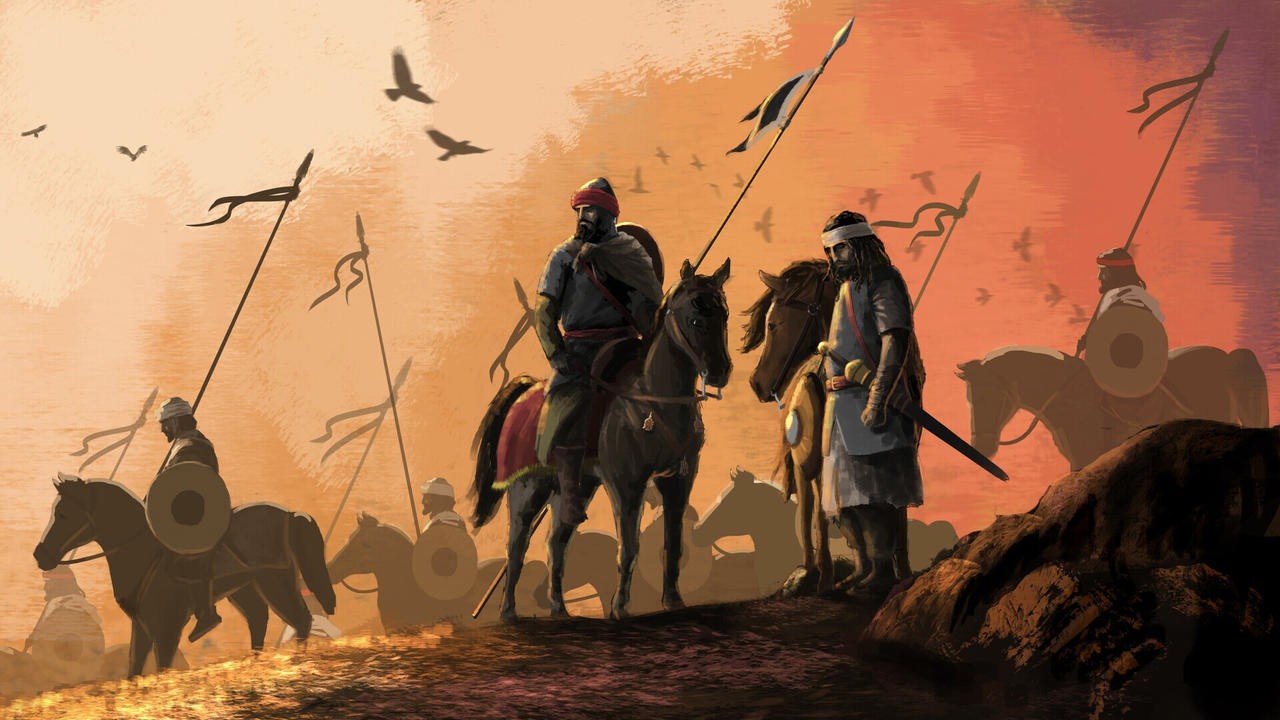
Khalid ibn al-Walid was a daring commander and a brilliant strategist. His exploits greatly contributed to the rapid expansion of the first Islamic caliphate. Having served under the great prophet Muhammad himself, al-Walid led the Arab armies with tremendous zeal and determination – earning him the nickname “the Sword of God”.
But Damascus, the first major city of the Eastern Roman Empire that they encountered, proved to be a formidable obstacle. Khalid ibn al-Walid would need to use all his courage and cunning to take this city for Islam.
Grab a short intro to the Caliphate(s) from our Medieval Guidebook.
Syria, and with it, Damascus, had become part of the Roman sphere of influence since the days of Julius Caesar. By 600 CE, the eastern half of the Roman Empire, better known as the Byzantine Empire, had reorganized its territory into dioceses – the would-be basis for bishoprics, hence the same name. Syria was part of the Diocese of the East, guarding the imperial border with the Persians.
The Romans/Byzantines and Persians were the two great powers of the Middle East and they were rivals. They had fought many a war against each other since 230 CE. Nevertheless, in 602, after more than 350 years of on-and-off conflict, the Persians thought the time was ripe for another round.
They launched a major offensive that set the entire region ablaze: fighting ranged from Egypt to Armenia, and from Mesopotamia to the walls of Constantinople itself. The Persians conquered Syria, but the Byzantines eventually retrieved it at great cost. In 628, after a devastating war that had lasted over a quarter of a century, the two powers agreed to stop fighting – exhausted and depleted of nearly all disposable resources.
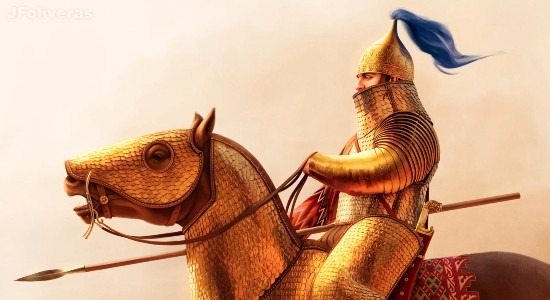
Meanwhile, in Arabia, events unfolded that would change the course of history. Only one year after the Byzantine-Persian ceasefire, the prophet Muhammad marched on Mecca. Another three years later, his forces had already united the entire Arabian peninsula under the banner of his new religion: Islam.
After their prophet’s death in 632, the muslims – after a succession dispute that, for a while, boiled over into civil war – chose Muhammad’s father-in-law Abu Bakr as his official successor, or “caliph”. That’s why the Islamic realm that arose over these years is known as the Caliphate. And, with the Byzantines still reeling from their cataclysmic Persian War and the Persians now in a state of civil war themselves, muslim forces started probing the defenses of both empires.
Spearheading one of the armies was a rising star in the muslim ranks, a commander named Khalid ibn al-Walid.
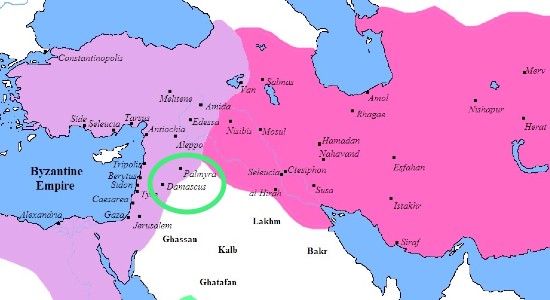
– advertisement –
– article continues below –
Khalid had already carved out quite the reputation by then. Earlier, he had even fought against Muhammad, leading the cavalry of the Meccan clans against the muslims and managing to injure the prophet himself – delivering a stinging setback to the nascent religion of Islam. In time, Khalid ibn al-Walid crossed over, converted to Islam, and received the honorific title of Sayf Allah, meaning “the Sword of God”.
By 633 CE, he was already raiding Persian Mesopotamia (present-day Iraq) and making good progress, at that. The caliph’s central goal, however, was the invasion of Byzantine Syria. Four armies were assembled to that end, tasked with four objectives: the conquest of Palestine, Jordan, Homs, and Damascus, respectively.

These four, “western” brigades had a tough time against the Byzantine Empire. Their commanders were rather inexperienced and the Byzantine emperor Heraclius was – to the muslims’ surprise – assembling great numbers to meet their attack. Caliph Abu Bakr came to the realization he needed the Sword of God in Syria and quickly rearranged his command structure, supposedly saying:
“By Allah, I shall destroy the Romans and the friends of Satan with Khalid ibn al-Walid.”
— Caliph Abu Bakr commenting on the state of his war against the Byzantines (or “Romans”)
This was easier said than done, however. Al-Walid was campaigning along the Euphrates and had only had two ways of getting into Syria from there:
The Sword of God decided to do neither. In a bold move that established his stature as a genius military strategist, he cut straight through the Syrian desert. At times, his men had to march for an entire day without coming across a single water source. Al-Walid had made proper preparations, though. He carefully regulated water distribution and even literally used camels as vases by increasing their water intake and then having them slaughtered at the end of the day to release the water from their intestines.
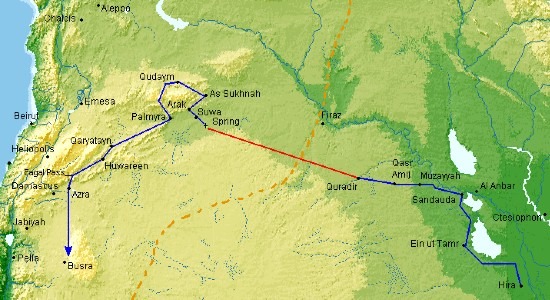
Al-Walid’s desert march completely unhinged the Byzantine defenses in Syria.
For the time being, the Byzantines had more or less managed the fend off the caliphate’s western armies. Now, another muslim force appeared in their rear – from the direction they least expected. The inevitable was no longer postponed: the imperial and caliphal armies joined battle. And despite suffering great casualties, the muslims ultimately carried the day.
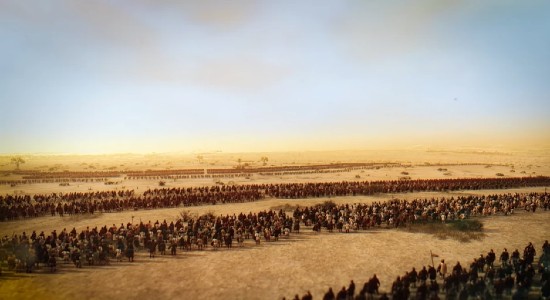
The Byzantines retreated north, with emperor Heraclius trying to assemble new forces near Antioch, on the Mediterranean coast. This left Damascus dangerously exposed, however. Within days, al-Walid’s 20,000-strong army surrounded the “Paradise of Syria”, as it was called – ready to wrest the first great city from Byzantine control for their caliph.
It was a major stronghold. A roughly circular wall of over 10 meters high protected the city from all sides. Furthermore, Heraclius’s son-in-law Thomas commanded the garrison, a man famous for his intelligence, courage and commander skills.
With the caliphate barely two years old, the muslims had little experience with siege warfare. They usually bided their time, relying on betrayal from within the defenders’ ranks or – ultimately – starving their opponents. Whilst efficient with regard to muslim casualties, this also meant sieges took up a lot of time, leaving the besiegers precariously exposed to any relief efforts by the enemy.
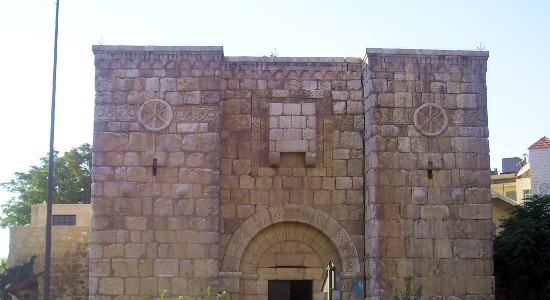
The Sword of God would not allow himself to be surprised, however. He posted detachments along the road north to Homs, to spy on and block any Byzantines rushing to Damascus’s aid – or to send word for help, should Heraclius himself march down from Antioch with the main corps of the Byzantine army. Additionally, because his forces were thinly spread along the city’s 5-kilometer-long wall, al-Walid ordered a mobile guard of 2,000 horsemen to permanently circle the city so they could reinforce his lines anywhere in case Thomas’s garrison would sally forth.
Determined to crush the caliphate while he still could, emperor Heraclius sent a relief force of 12,000 strong to Damascus. Because of his prudent precautions, al-Walid quickly learned of the Byzantine plans and sent north around 5,000 men. They were to hold a crucial pass to block the Byzantines’ advance, while he bought himself time to think.
In the event, the Sword of God was caught in a difficult two-front situation. He absolutely needed to defeat the Byzantine relief force, lest his besieging forces be attacked in their rear. On the other hand, with Thomas anxiously spying all his movements from atop Damascus’s battlements, he could not risk withdrawing too many men north without dangerously understaffing his own siege attempt.
When reports reached him that his forces in the mountain pass were hard-pressed by the overwhelming Byzantine army, the muslim general cast the die. Khalid ibn al-Walid took another 4,000 men with him and rode north, practically halving his besieging army in the process. He arrived at the pass in time to save the day, beating back the Byzantine relief army.
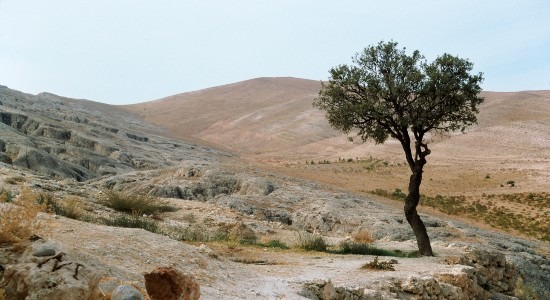
Military historians agree that, had Thomas meanwhile sallied forth from his city’s walls, he probably would have managed to break through the muslim siege lines, delivering a major blow to the caliphate’s attempts to conquer the region. However, commander Thomas faced just as difficult a choice as his opponent: he could attack now and risk defeat, or gamble on his father-in-law winning to the north and lifting the siege.
In the event, Thomas decided to wait and see what would happend, and al-Walid – realizing the danger he was in despite his victory in the pass – hurried back to Damascus. He found the city as he left it and, back in full strength, redoubled his efforts to choke the city. When he saw the Sword of God returning underneath his walls, Thomas knew his father-in-law had failed him.
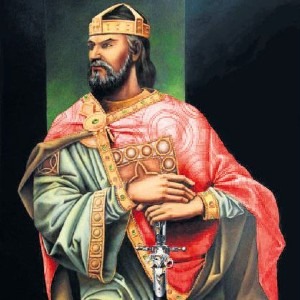
Where other commanders may have despaired and surrendered, Thomas saw only one way out: to sally forth and defeat the muslims in open combat. He gathered most of his forces, deployed them in the east of the city, and gathered them near the gate. He then ordered his archers on the walls to shower the besiegers with arrows, so his men could rush out and deploy underneath the walls in battle formation.
Thomas personally led the counter-attack. He fought a pitched battle near Damascus’s eastern gate, during which he was struck in his eye by an arrow. The Byzantine commander allegedly swore that he would take a thousand eyes in return, but as Byzantine casualties mounted, Thomas eventually ordered his men to retreat back into the city.
Restless, the Byzantine commander made new plans for the coming night. Under the cover of darkness, his men would sortie again - but this time they would simultaneously use four of Damascus’s six gates. Thomas thus aimed to throw the muslim ranks into disarray.

Near the western gate, the Byzantine attempts were futile and al-Walid’s forces easily threw them back into the city. In front of the southwestern gate, the situation became more serious: the Byzantines almost succeeded in breaking through, until the mobile guard circling the city intervened and turned the tide of battle. At the eastern gate, a similar situation developed – only by plunging himself into the Byzantine flank with 400 reserve cavalrymen did the Sword of God send his enemies scurrying back into the city.
The northeastern gate spewed forth the fourth sortie, with Thomas himself in command. Fighting was fierce whilst the Byzantines held their own. But when word reached him from the other sectors, Thomas realized that further bloodshed was pointless and he again ordered a full retreat.
– advertisement –
– article continues below –
With the Byzantines bruised and bloodied, Khalid ibn al-Walid expected that now it was his turn to dictate the pace of the engagement. But events caught up with him once more.
On September 18, 634, a priest inside Damascus – called Jonah – snuck out a message to Khalid of a festival celebration that night, which would probably leave the walls unusually unguarded. In return, Jonah asked for immunity for himself and his fiancé – the very betrayal that besieging forces of the early caliphate counted on seemed to be happening once again.
Lacking the time to organize a coordinated attack that very night, the Sword of God decided to personally storm the eastern gate, which was directly in front of his headquarters. As night fell, Damascus’s walls indeed appeared suspiciously quiet. Khalid scaled the eastern wall with a couple of hand-picked men and a good deal of rope. Once they reached the top, not a single Byzantine was in sight. He dropped down the rope and 100 carefully selected soldiers joined him on the ramparts: Jonah apparently had spoken the truth.
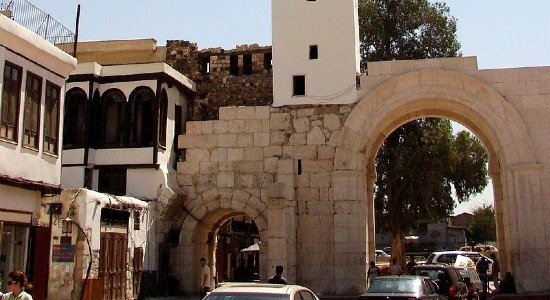
Al-Walid’s men flung open the eastern gate to let the rest of their division inside. The sound they made finally alerted the Byzantines in this part of the city, who rushed to the gate to save the situation. An intense battle ensued that lasted for hours.
Thomas, from a vantage point in the city center, noticed how the other muslim brigades didn’t move. He rightfully deduced that Khalid had discussed and executed his plan with his own division only. Fearful of the wrath that might follow the conquest of the city by the Sword of God, Thomas sent a message to the muslim commander on the opposite side of the city, proposing terms.
This commander, who was Khalid’s second-in-command and oblivious to his superior’s siege attempts on the other side of the city, quickly agreed to the terms - fully expecting Khalid to be just as rejoiced as he was that the siege would be over.
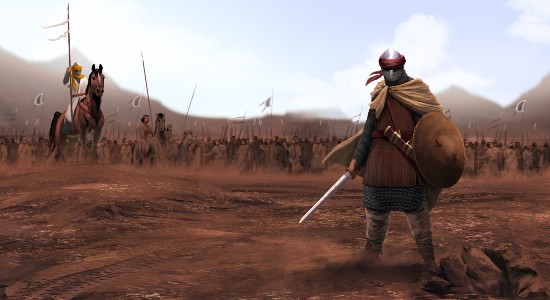
A peculiar situation now developed: word that the Byzantines had surrendered spread to the other muslim divisions, except Khalid’s own corps, which was still battling their way into the city. As dawn broke, Khalid’s second-in-command entered Damascus’s western gate in peace, accompanied by Thomas himself and the city’s bishop. When they reached the central plaza, Khalid himself just stormed onto the square from the eastern side – blood-stained and exhausted after a whole night of fighting.
Neither of the muslim generals immediately understood the situation. Khalid ibn al-Walid stared at his second-in-command, confused as to how he got into the city as well – and with the Byzantine commander at his side, too! His subordinate, on the other hand, had no clue why his superior practically rolled onto the square, sword in hand and in absolute battle mode, when he himself had just concluded a treaty with Heraclius’s son-in-law that delivered the city to the caliphate.
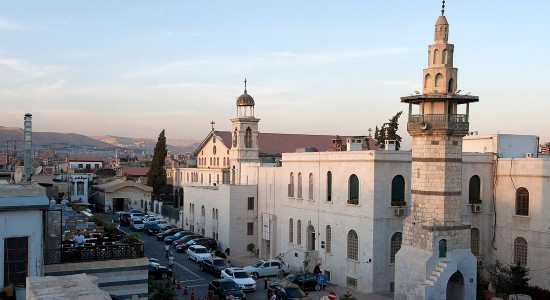
It took a while to work out all the details in the sparse morning light. The Sword of God argued that he had just taken Damascus by storm. His second-in-command maintained that Thomas had surrendered this very morning, allowing for the city to be taken “in peace”.
The muslim commanders discussed the situation at length, but eventually Khalid acquiesced: he declared that the surrender agreement must be honored. Its terms were that nobody was to be enslaved, all of Damascus’s religious buildings were to be respected, no booty or plunder was to be taken, and – most importantly – any inhabitant who did not wish to live under the caliph’s rule was given safe passage to Byzantine territory.
In return, everybody who stayed and didn’t convert to Islam had to pay the jizya – a per-capita yearly tax levied on non-muslims. Furthermore, the caliphate confiscated all imperial buildings inside Damascus. This agreement, signed after the capture of the first great Byzantine city that the Islamic armies encountered, served as a model for future capitulation agreements in Mesopotamia, Egypt and Greater Syria.
– advertisement –
– article continues below –
The safeguard granted by the treaty only lasted for three days. Khalid ibn al-Walid, rather unsatisfied by how great Damascus had formally fallen by surrender rather than by his own courageous capture, harried Jonah for more information. The sly priest showed the Sword of God a shortcut to Antioch, to where Thomas and his remaining men were retreating.
After the three days of the armistice agreement had lapsed, Khalid attacked Thomas’s convoy on the way and reportedly killed him in a duel. The muslims captured his wife, emperor Heraclius’s daughter. To reward him for his services, Khalid offered her to Jonah – his fiancé having committed suicide earlier, after she learned what her husband-to-be had done.
Jonah refused the Byzantine princess, after which the Sword of God sent her back to her father in Antioch. With his daughter safe, Heraclius resumed to organizing new counter-attacks. The conflict between the Byzantines and the Caliphate continued.
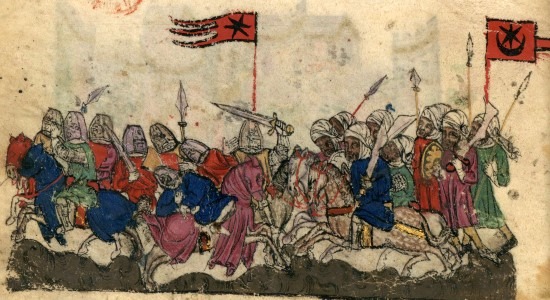
A great battle was fought near the Yarmouk river, in northern Israel, nearly two years after the Siege of Damascus. The Sword of God was again in command and utterly shattered the Byzantine army. Afterward, the Diocese of the East fell piece by piece into muslim hands, with Jerusalem – that holy city that Muhammad himself had purportedly visited – becoming part of the caliphate in 637 or 638.
One might be forgiven for thinking that surely this would necessitate the caliph to overload his star general with gifts and honors, after so many spectacular accomplishments? It was not so. Abu Bakr died before the Siege of Damascus ended and the new caliph, Umar, was an enemy of Khalid.
Umar demoted the Sword of God after his great victory near the Yarmouk. Sometime later, the caliph even dismissed him altogether. A close associate of Khalid protested that this violated the trust conferred upon the general by Muhammad himself – after all, the title Sayf Allah was given to him by the great prophet.
But this man was the only one to speak up. The rest of the army acquiesced to the caliph’s commands. He was Muhammad’s official successor, after all.
Khalid died in Homs or Medina in 642 CE, eight years after the Siege of Damascus. And although he didn’t live to see this particular result, his accomplishments came back to haunt caliph Umar and his successors after all. The second muslim governor of Damascus, called Mu’awiya, eventually overthrew Abu Bakr’s and Umar’s line of caliphs and founded the Umayyad dynasty in 661.
The new ruler Mu’awiya I, of course, chose as the capital of his Umayyad Caliphate his very own power base: the city of Damascus.
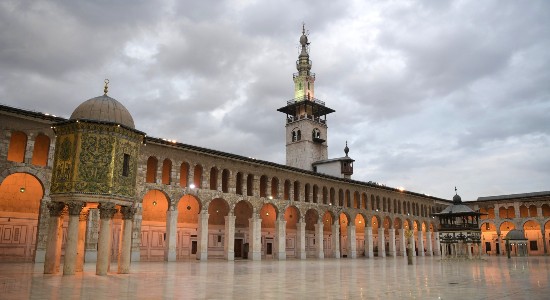
Disclosure: we work hard to provide you with exclusive medieval reports and guides. To make the Middle Ages accessible to everybody, we’d like this information to remain FREE. Therefore, some of the links below are affiliate links, meaning – at no additional cost to you – we will earn a small compensation if you click through.
Featured Image Credit: Mubarizun (ArtStation)
Comments are closed.
The article in interesting. However, one fact is just simply a lie. Kindly stop distorting muslim history. Umar was the caliph ( Rashidun Caliph ) and Khalid was a muslim subservient to the Caliph. They were allies. Period.
Hi Khurram, thanks for commenting! We base our perspective on the uneasiness between Umar and Khalid on several scientific sources, such as Gautier Juynboll and Andrew Latham. If you have found material that pleads the opposite case, we’d be very happy to read it!
Thiss site is really good
Thanks a lot, Clay!